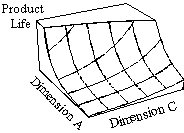

Many manufacturers devote substantial resources in time, money
and effort to reliability testing. This helps reduce warranty
costs and increase customer satisfaction; the increased customer
satisfaction translates into a higher rate of repeat business
and referrals, which is the only way that companies in competitive
markets stay in business for the long term. Many manufacturers
could get more information with less testing by using experimental design
techniques to help plan and analyze the results.
The above figure summarizes the impact on product life uncovered
by a series of experiments performed to solve a reliability problem.
The project team found that it was most important to control "Dimension
A", though "Dimension C" also contributed to product
life.
For more information about reliability experimentation, ask for
a free copy of "Designing Experiments to Measure and Improve
Reliability" by Spencer Graves and Tom Menten (ch. 11 in
Ireson, Coombs and Moss, Handbook of Reliability Engineering
and Management, NY: McGraw-Hill, 1996). Call (408)294-5779,
fax: (408)294-2343, or e-mail: sgraves@prodsyse.com.
Other Productive Systems Engineering programs: Product Development,
Designed Experiments (Design of Experiments,
DoE or DOX), Tolerancing, Quick Start Total Quality
(Total Quality Control, TQC / Total Quality Management, TQM),
Statistical Process Control (SPC); Fiber Optic Communication/Transmission Systems
(FOCS or FOTS); Control and Monitoring
(RMM); Electronics (Theory & Application);
Production Line Assembly for Technicians
(Assembly).